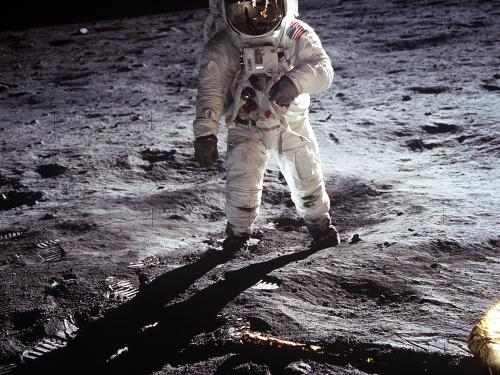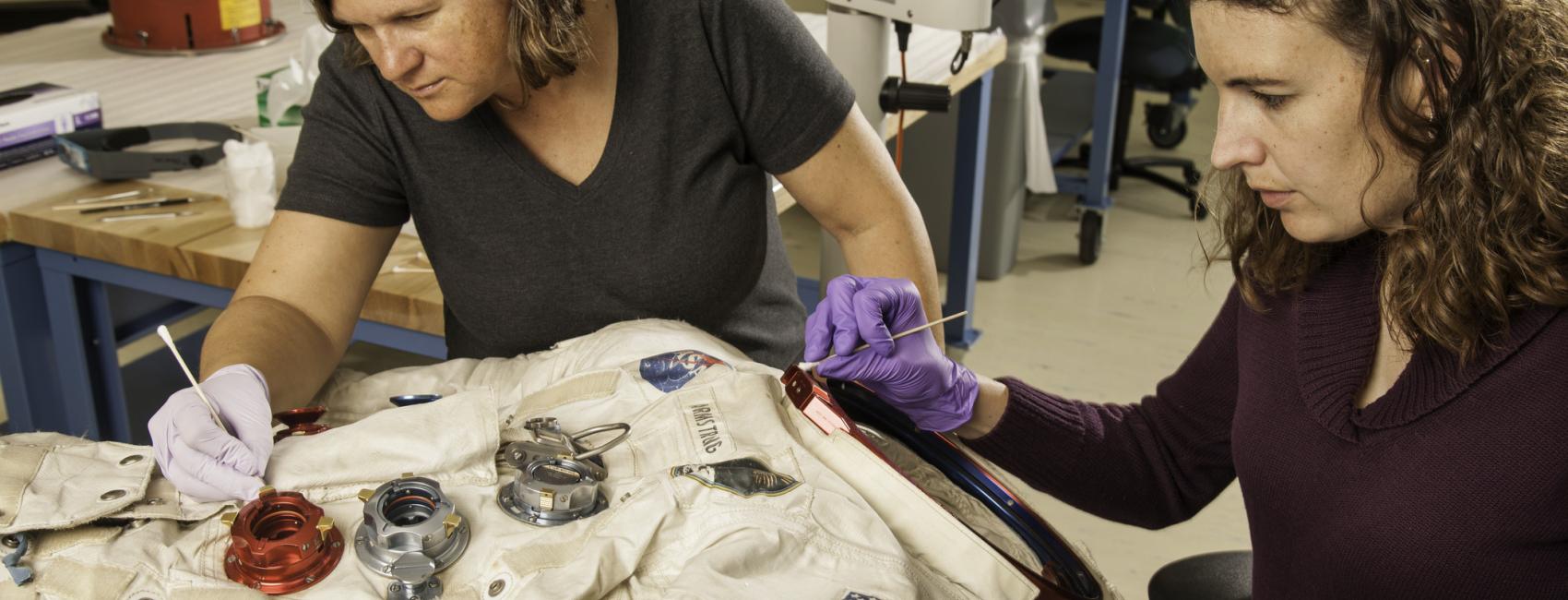

Dec 21, 2022
Many artifacts from the Apollo missions are closer than you think.
History came full circle at the Kennedy Space Center as Artemis I, carrying an uncrewed Orion capsule, roared off the launchpad on November 16, beginning a 25-day test flight around the moon and back to Earth. The launch was almost 50 years to the day that a Saturn V rocket took off, carrying the crew of Apollo 17, including the two astronauts—Eugene Cernan and Harrison “Jack” Schmitt—who would be the last to walk on the lunar surface.
The Artemis I mission that successfully ended with a splashdown on December 11 enables us to further appreciate the accomplishments of the Apollo program, which achieved what many deemed impossible with technology that is now over half a century old. Visitors to the Smithsonian’s National Air and Space Museum can appreciate these achievements firsthand. The Museum holds approximately 17,000 space artifacts in its collection—and more than 3,500 stem from the historic Apollo moon landing effort.
Some of these artifacts might be closer to you than you realize. Through collaborations with affiliate organizations, the Smithsonian sponsors traveling exhibits and shares artifacts with museums throughout the U.S. and abroad, including more than 300 artifacts from the Apollo program.
We’re showcasing some of these items in this issue of ASQ. And, of course, we recommend that you check with your local museums to confirm these artifacts are currently on display before you and your family begin your own expedition of discovery.
An F-1 engine is on display at the Air Zoo Aerospace & Science Museum in Portage, Michigan. The engine’s 2,500-pound turbopump loaded propellants at 42,500 gallons per minute. (Aaron Headly/Flickr)
Taller than the Statue of Liberty and weighing 6.2 million pounds when fully fueled, NASA needed extraordinarily powerful engines to get the Saturn V rocket off the launchpad, into orbit, and on a trajectory for the moon. The powerhouse of the rocket’s first stage was the F-1 engine, developed and built by the Rocketdyne Division of North American Rockwell. A single F-1 engine could generate 1.5 million pounds of thrust—a potential energy output equivalent to about 17 Hoover Dams. Rocketdyne delivered 98 F-1 engines to NASA, 65 of which powered Saturn V vehicles. The National Air and Space Museum acquired around half a dozen, some of which can be seen at venues that include the U.S. Space & Rocket Center in Huntsville, Alabama, and the New Mexico Museum of Space History in Alamogordo.
The F-1s didn’t do the job alone. The J-2 rocket engine was the powerplant for the second and third stages of the Saturn V, which used five and one of the engines, respectively. The J-2 had a maximum vacuum thrust of 225,000 pounds.
As with the F-1, you can see some of Museum’s J-2 engines up close at venues that include the Museum of Life and Science in Durham, North Carolina. Some museums also have the H-1 engine that was used for the Saturn 1 and Saturn 1B rockets, which were precursors to the Saturn V.
Eugene Cernan dines aboard the Apollo 17 command module.
A four-ply, laminated film coating protected the food from loss of flavor, moisture, spoiling, and excess crumbling.
During the early years of the space program, Gemini astronaut meals consisted of mashed food that was packed into tubes and sucked through a straw. The Apollo crew members dined on much tastier fare, largely thanks to NASA physiologist Rita Rapp, who created recipes that fit the preferences of each astronaut.
The Apollo crew members ate three meals per day, providing approximately 2,800 calories.
The food was freeze-dried and then reconstituted by dispensing one-half ounce of hot or cold water as required.
A cornucopia of Apollo-era space cuisine—like a package of beef with vegetables (pictured)—can be seen (but not eaten) at museums such as the Frontiers of Flight Museum in Dallas, Texas.
Read about Apollo food specialist Rita Rapp
The Apollo 9 command module resides at the San Diego Air & Space Museum. It is one of only two command modules flown in space that are on display west of the Rocky Mountains. (Melodie Mesiano/Flickr)
The spacecraft that carried the Apollo astronauts to the moon were cramped, conical capsules that looked more like lifeboats than the mighty spaceships that had been featured in science-fiction books and movies. But the command module got the job done, sustaining three crew members for two weeks as they flew through the darkness of space. The central crew area—the only pressurized compartment in the vessel—had a habitable volume of just 210 cubic feet and housed the crew couches, main control panels, food and equipment lockers, waste management system, and docking tunnel.
The command modules are the only part of the Apollo spacecraft configuration that returned to Earth and 12 of them are exhibited throughout the United States and abroad. The Apollo 11 command module, now on display at the National Air and Space Museum in Washington, D.C., traveled the country during a 2019 exhibition, “Destination Moon: The Apollo 11 Mission.”
Many of the tools used by the Apollo astronauts were designed for the lunar surface. One such piece of equipment, which NASA dubbed “scongs,” was a combination scoop-and-tong for collecting small samples of soil and rocks. Other tools—wrenches, hammers, flashlights—were very similar to ones routinely used on Earth. A variety of tools, including a 70mm camera and a training version of the Apollo lunar surface drill, can be seen at the Armstrong Air & Space Museum in Wapakoneta, Ohio.
Each Apollo mission was equipped with survival kits that included desalination chemicals, sunglasses, a radio beacon, and a machete.
The Stafford Air & Space Museum in Weatherford, Oklahoma, features some rather exotic items included in the Apollo 15 survival kit, an array of supplies that could have helped the crew survive for up to 48 hours after landing—either in the water or on land.
Apollo 11 astronaut Michael Collins spent more than 250 hours training in the command module simulator, using this instrument panel.
Measuring nearly seven feet wide and three feet tall, the Apollo command module’s main display panel dominated the forward section of the capsule’s crew area. The panel was divided into three sections, reflecting the duties of each astronaut: pilot, navigator, and flight engineer. (The panel pictured above was part of the command module simulator at the Kennedy Space Center and is now on display at London’s Science Museum.)
The control panel had a display keyboard unit, or DSKY (pronounced “diskey”), which enabled astronauts to communicate with the Apollo guidance computer. The interface consisted of a numerical keyboard, a row of status lights, and a set of lighted numerical indicators. Astronauts keyed in numerical codes in a verb-noun sequence (such as “display velocity”). The Smithsonian has four DSKYs out on loan, including one that flew on Apollo 16, at the U.S. Space & Rocket Center in Huntsville, Alabama.
This headset, worn by Apollo 11 astronaut Neil Armstrong, is exhibited at the Cincinnati Museum Center at Union Terminal.
The bulky astronaut pressure suits—including those worn by Jim Lovell on Apollo 13 and Ronald Evans on Apollo 17—can be seen in multiple venues across the U.S., along with communications headsets and life-support equipment. Also, keep an eye out for flight jackets, such as the one worn by Apollo 17 astronaut Harrison Schmitt (on display at the Roswell Museum and Art Center in New Mexico).
Smithsonian Affiliate spotlight
Alamogordo, New Mexico
The New Mexico Museum of Space History, a Smithsonian Affiliate, was established in 1976 and has several space-theme exhibits, including the International Space Hall of Fame and the John P. Stapp Air and Space Park. Through the eyes of Chrystal Jackson, a watercolor painter in the NASA Art Program, visitors can see what Florida’s Cape Canaveral looked like in the 1960s.
Smithsonian Affiliate spotlight
Hutchinson, Kansas
The Cosmosphere International SciEd Center & Space Museum is a Smithsonian Affiliate with a collection of U.S. space artifacts second only to the Smithsonian’s. It also has the largest collection of Russian space artifacts outside of Moscow.


We rely on the generous support of donors, sponsors, members, and other benefactors to share the history and impact of aviation and spaceflight, educate the public, and inspire future generations. With your help, we can continue to preserve and safeguard the world’s most comprehensive collection of artifacts representing the great achievements of flight and space exploration.
We rely on the generous support of donors, sponsors, members, and other benefactors to share the history and impact of aviation and spaceflight, educate the public, and inspire future generations. With your help, we can continue to preserve and safeguard the world’s most comprehensive collection of artifacts representing the great achievements of flight and space exploration.